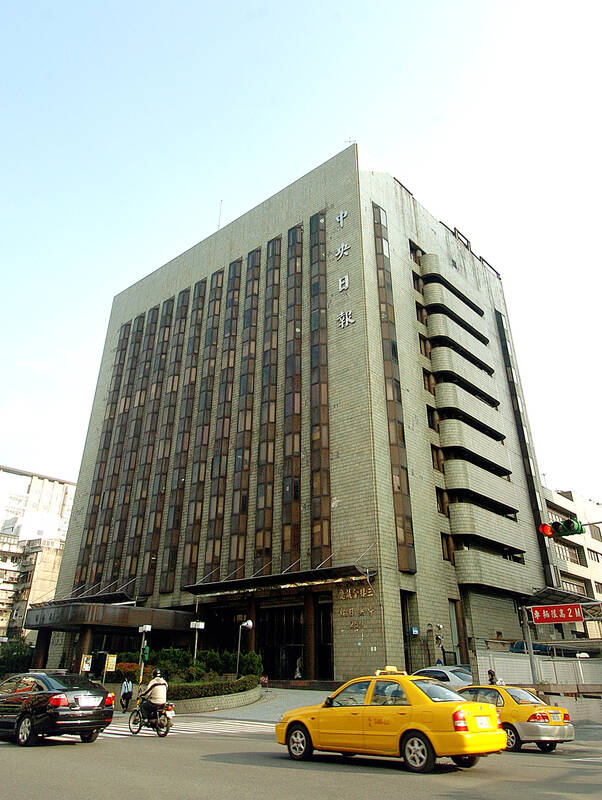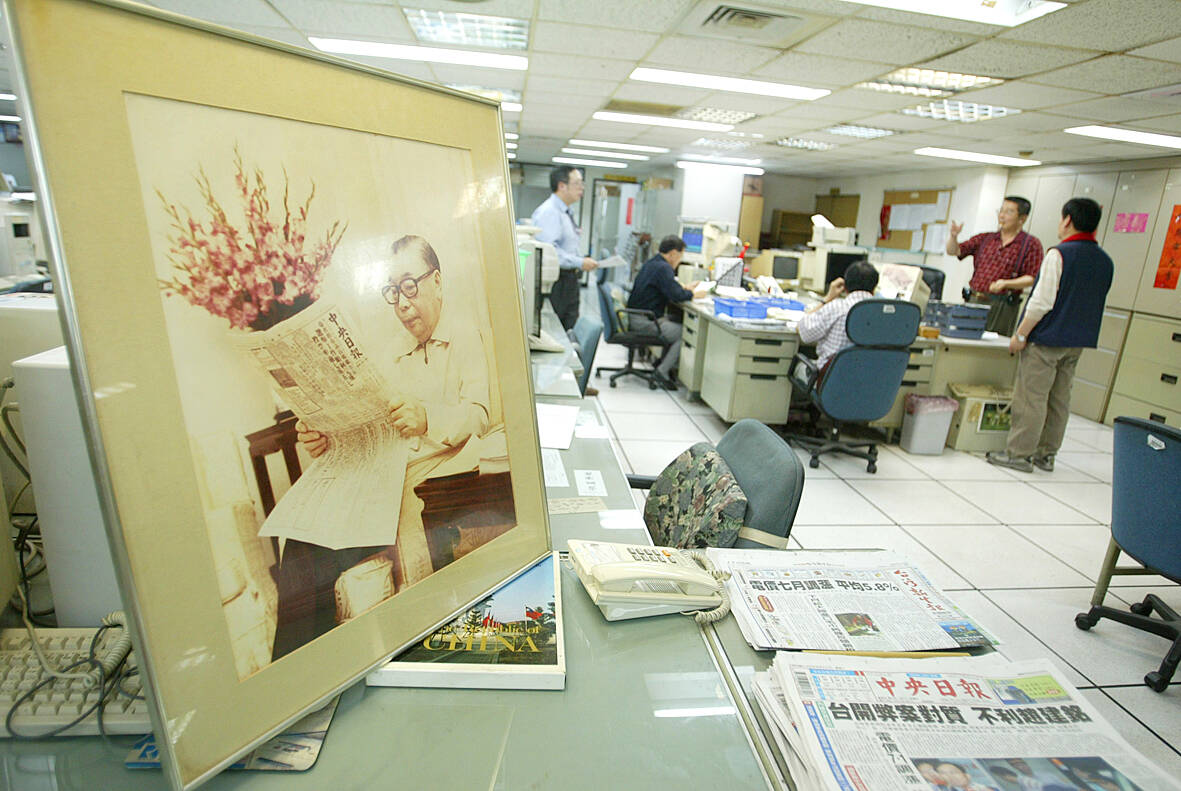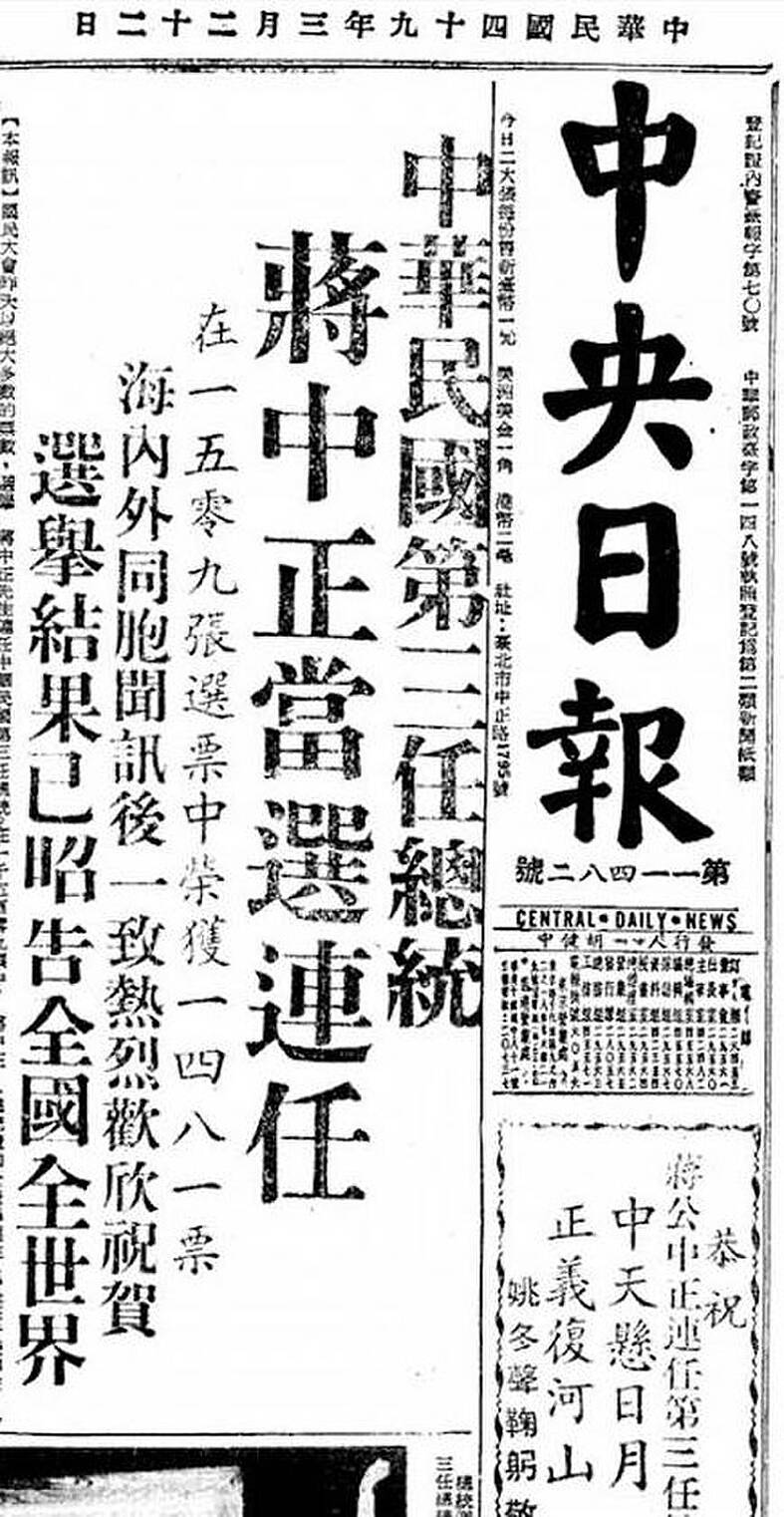May 28 to June 3
Taiwan provincial governor Chen Cheng (陳誠) was adamantly opposed to the state-run Central Daily News (中央日報) moving from Nanjing to Taipei in 1949.
The Chinese Nationalist Party (KMT) already had a mouthpiece in Taiwan, the China Daily News (中華日報), and he argued that the relocation of the Central Daily News “would have absolutely no function besides affecting the morale of the people,” according to the book 1949: An Earth-Shattering Year (1949: 石破天驚的一年) by Lin Po-wen (林博文).

Photo: Fang Pin-chao, Taipei Times
Chen likely had a grudge against the paper too. Despite editor-in-chief Tao Hsi-sheng’s (陶希聖) “central first, then daily” policy prioritizing the government over journalism, US-educated publisher Ma Hsing-ye (馬星野) and the young news staff often defied the rules, exposing scandals and criticizing politicians — including Chen.
“Please kill Chen Cheng to appease the wrath of the world,” one headline stated, referring to Chen’s boasts when he was chief of staff of the Republic of China (ROC) army that they would wipe out the communists in three months.
However, starting in October 1948, the paper’s staff had been moving its equipment and staff to Taiwan as the KMT lost ground in the Chinese Civil War. After much pleading, Chen relented and the paper resumed operations in Taipei on March 12, 1949. It helped that KMT leader Chiang Kai-shek (蔣介石) seemed to care a lot about the fate of the paper, personally meeting with the publishers before leaving Nanjing and often inquiring about the relocation progress.

Photo: CNA
Due to government control over the media, Central Daily News was Taiwan’s largest newspaper for the next decade before being surpassed by the United Daily News (聯合報) in 1959. The changing times and massive financial losses finally forced it to shut down on June 1, 2006 after 78 years in operation.
THE BIG MOVE
The paper was founded in Shanghai in February 1928 explicitly as the mouthpiece of the KMT. It relocated to Nanjing the following year. There were numerous party-run papers during that time, and the effectiveness of Central Daily News was hampered by party factionalism.

Photo: Chao Hsih-hsun, Taipei Times
The paper was incorporated in 1946 and flourished under the leadership of publisher Ma, who was educated at the Missouri School of Journalism in the US. The paper’s editorials and opinion pieces still promoted party policy, but the news reporters, mostly Ma’s former journalism students at National Central University of Governance (today’s National Cheng Chi University), were given substantial editorial freedom.
This liberal period, however, did not last long. The government clamped down in July 1947 after two reporters exposed two high-ranking officials of embezzlement.
Although numerous private newspapers were founded in Taiwan after World War II, most did not last long or reach a large audience due to lack of resources and language barriers, as the government banned the use of Japanese to promote Mandarin. The arrival of the Central Daily News exacerbated the hardships, writes Chen Chih-chang (陳志昌) in Reconstruction: The Early Development of ‘Central Daily News’ in Taiwan (重起爐灶:遷台初期的《中央日報》1949-1953).

Photo courtesy of Wikimedia Common
However, the Central Daily News struggled too, especially as it had to support more than 100 staff and their families who relocated with it from China. The paper was first housed in a cramped building on Hankou Street in Taipei, where many staff also lived.
“Our desks became our beds at night, and the office was also the dining room,” Ma recalls. “We waited eagerly everyday for some ad revenue to come in so our colleagues could survive.”
With the help of provincial governor Wei Tao-ming (魏道明), the paper was given another office on Zhongxiao W Rd. This building was already occupied by two entities that were displeased at having to give up part of their space, and the atmosphere was tense, with staff on both sides nearly coming to blows once.
Equipment was also lacking. To keep the paper running in Nanjing during the war, only about half of the printers were shipped to Taiwan. They had earlier ordered a new, state-of-the-art printer from Goss International, but didn’t have enough money to fly someone in from the US to set it up.
NEWS BEFORE PARTY?
The remaining KMT newspapers in China did not survive the war, and by the end of 1949 the party only had the China Daily News, which was based in Tainan, and Taiwan Shin Sheng Daily (台灣新生報), run by the provincial government.
Due to the extra resources it enjoyed as the central paper, Central Daily News caught up to the other two papers in circulation within three months of its arrival. Competition with the Taiwan Shin Sheng Daily was especially fierce, leading to several conflicts that had to be mediated by KMT party elders.
Ma and his reporters were critical of the government at first. In May 1949, they blamed Taiwan’s severe inflation on National Assembly members, who they described as privileged “locusts” who live lavishly no matter how poor the people are. They later called government officials “political trash that needed to be cleaned.”
Ma ignored the objections from the KMT, which led to 85 legislators calling out the newspaper of “improper speech” later that year. In January 1950, the party’s Central Control Commission “seriously warned” Ma and his staff to watch their words. Chen writes that Chiang was actually tired of the insatiable demands by the political bigwigs, and let the paper off lightly.
Chen writes that the paper toned down its speech after the first year and remained relatively conservative compared to private newspapers. With the death and retirement of several officials involved with the paper, by late 1950 the editorial stance was firmly under the control of Chiang and the central propaganda committee.
SLOW DOWNFALL
Ma left the paper in 1952, and the next two publishers were staunch Chiang loyalists with propaganda backgrounds. Lin Po-wen writes that while the United Daily News and China Times continued to expand their content and reach, the Central Daily News became more conservative. Despite their superior resources, they simply could not compete.
The government’s 36-year ban on establishing new newspapers was lifted on Jan. 1, 1988, and with the end of the KMT’s one-party rule and increasing exchanges with China, subscriptions and ad sales for the Central Daily News plummeted.
In 1990, former Central Daily News news director Lu Chiang (陸鏘), who lost his job after exposing government corruption in 1947, visited Taiwan. Lu had gone through a lot; he was first jailed by the KMT for starting his own paper, then branded as a rightist by the communists and imprisoned for 18 years before fleeing to Hong Kong.
Then-newspaper chairman Chu Sung-chiu (楚崧秋) asked Lu if he had any suggestions for the floundering paper.
Lu said the paper did well when it first moved to Taiwan, but the managers after Ma were too concerned with being loyal and patriotic, prioritizing “being good officials over running a proper newspaper.”
He reminded Chu of his team’s “daily first, then central” attitude more than four decades later, but it was too late by then.
Taiwan in Time, a column about Taiwan’s history that is published every Sunday, spotlights important or interesting events around the nation that either have anniversaries this week or are tied to current events.

This month the government ordered a one-year block of Xiaohongshu (小紅書) or Rednote, a Chinese social media platform with more than 3 million users in Taiwan. The government pointed to widespread fraud activity on the platform, along with cybersecurity failures. Officials said that they had reached out to the company and asked it to change. However, they received no response. The pro-China parties, the Chinese Nationalist Party (KMT) and Taiwan People’s Party (TPP), immediately swung into action, denouncing the ban as an attack on free speech. This “free speech” claim was then echoed by the People’s Republic of China (PRC),

Exceptions to the rule are sometimes revealing. For a brief few years, there was an emerging ideological split between the Democratic Progressive Party (DPP) and Chinese Nationalist Party (KMT) that appeared to be pushing the DPP in a direction that would be considered more liberal, and the KMT more conservative. In the previous column, “The KMT-DPP’s bureaucrat-led developmental state” (Dec. 11, page 12), we examined how Taiwan’s democratic system developed, and how both the two main parties largely accepted a similar consensus on how Taiwan should be run domestically and did not split along the left-right lines more familiar in

As I finally slid into the warm embrace of the hot, clifftop pool, it was a serene moment of reflection. The sound of the river reflected off the cave walls, the white of our camping lights reflected off the dark, shimmering surface of the water, and I reflected on how fortunate I was to be here. After all, the beautiful walk through narrow canyons that had brought us here had been inaccessible for five years — and will be again soon. The day had started at the Huisun Forest Area (惠蓀林場), at the end of Nantou County Route 80, north and east

Specialty sandwiches loaded with the contents of an entire charcuterie board, overflowing with sauces, creams and all manner of creative add-ons, is perhaps one of the biggest global food trends of this year. From London to New York, lines form down the block for mortadella, burrata, pistachio and more stuffed between slices of fresh sourdough, rye or focaccia. To try the trend in Taipei, Munchies Mafia is for sure the spot — could this be the best sandwich in town? Carlos from Spain and Sergio from Mexico opened this spot just seven months ago. The two met working in the